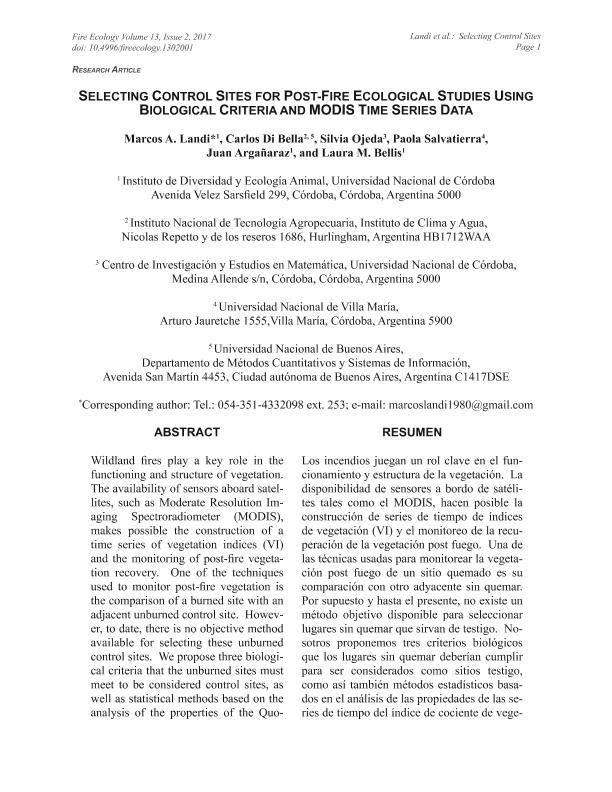Artículo
Selecting control sites for post-fire ecological studies using biological criteria and modis time series data
Landi, Marcos Alejandro ; Di Bella, Carlos Marcelo
; Di Bella, Carlos Marcelo ; Ojeda, Silvia; Salvatierra, Paola Luciana; Argañaraz, Juan Pablo
; Ojeda, Silvia; Salvatierra, Paola Luciana; Argañaraz, Juan Pablo ; Bellis, Laura Marisa
; Bellis, Laura Marisa
 ; Di Bella, Carlos Marcelo
; Di Bella, Carlos Marcelo ; Ojeda, Silvia; Salvatierra, Paola Luciana; Argañaraz, Juan Pablo
; Ojeda, Silvia; Salvatierra, Paola Luciana; Argañaraz, Juan Pablo ; Bellis, Laura Marisa
; Bellis, Laura Marisa
Fecha de publicación:
02/2017
Editorial:
Association for Fire Ecology
Revista:
Fire Ecology
ISSN:
1933-9747
Idioma:
Inglés
Tipo de recurso:
Artículo publicado
Clasificación temática:
Resumen
Wildland fires play a key role in the functioning and structure of vegetation. The availability of sensors aboard satellites, such as Moderate Resolution Imaging Spectroradiometer (MODIS), makes possible the construction of a time series of vegetation indices (VI) and the monitoring of post-fire vegetation recovery. One of the techniques used to monitor post-fire vegetation is the comparison of a burned site with an adjacent unburned control site. However, to date, there is no objective method available for selecting these unburned control sites. We propose three biological criteria that the unburned sites must meet to be considered control sites, as well as statistical methods based on the analysis of the properties of the Quo-tient Vegetation Indices time series (QVI), to detect unburned sites that meet the proposed criteria. We also test the performance of the proposed method by checking the pre-fire difference between burned and unburned sites, assuming that the higher the number of met criteria, the greater the similarity. Therefore, we compare the differences between VI time series of burned sites and VI time series of unburned sites with the same vegetation cover that meet three, two, one, and none of the proposed criteria. In addition, we compare the quality of QVI time series that meet three, two, one, and none of the proposed criteria. Our results show that, for Normalized Difference Vegetation Index (NDVI) and Enhanced Vegetation Index (EVI) data, the difference between the time series of burned and unburned sites gradually decreases with the increase of met criteria. A gradual increase is also observed in the quality of the QVI time series with the increase of met criteria. Despite the limitations present in the proposed method, our model represents an advance from the conceptual and methodological standpoints, since this is the first proposal of a statistical method for selecting unburned control sites based on biological criteria.
Archivos asociados
Licencia
Identificadores
Colecciones
Articulos(IDEA)
Articulos de INSTITUTO DE DIVERSIDAD Y ECOLOGIA ANIMAL
Articulos de INSTITUTO DE DIVERSIDAD Y ECOLOGIA ANIMAL
Citación
Landi, Marcos Alejandro; Di Bella, Carlos Marcelo; Ojeda, Silvia; Salvatierra, Paola Luciana; Argañaraz, Juan Pablo; et al.; Selecting control sites for post-fire ecological studies using biological criteria and modis time series data; Association for Fire Ecology; Fire Ecology; 13; 2; 2-2017
Compartir
Altmétricas



